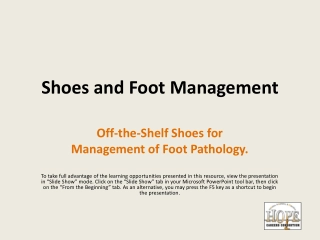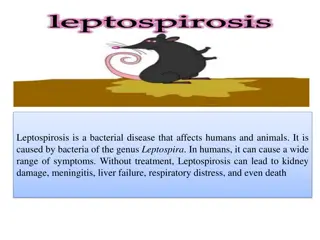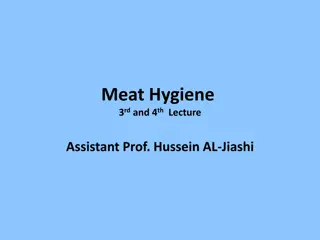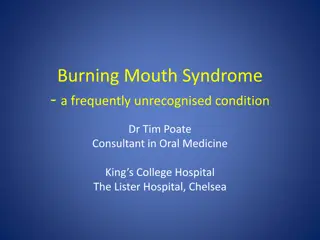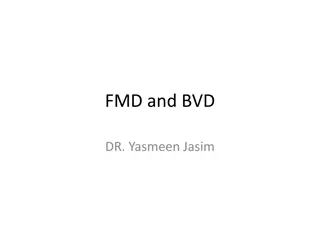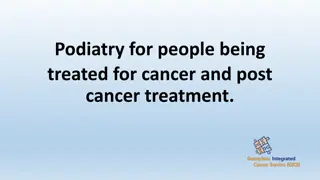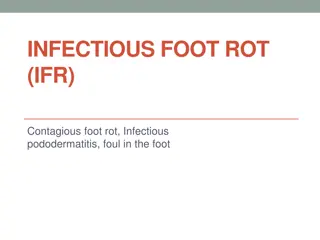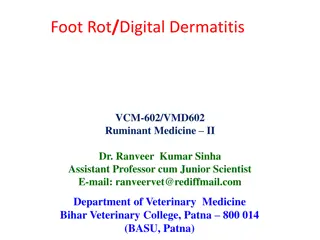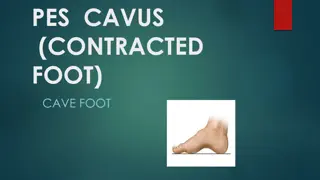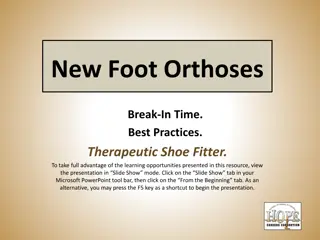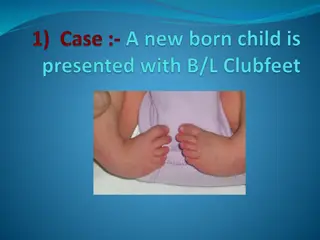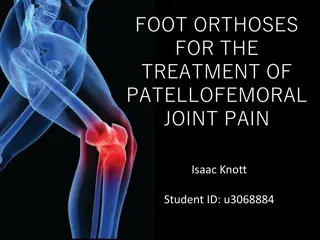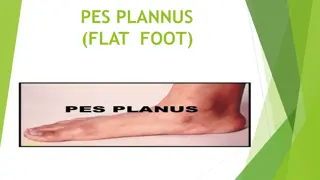Understanding Foot and Mouth Disease in Animals: Causes, Symptoms, and Management
Foot and Mouth Disease is an acute, highly contagious illness affecting cloven-hoofed animals, causing vesicles and erosions in the mouth, nose, teats, and feet. The disease is caused by a positive sense, ss-RNA virus with various serotypes. Transmission occurs through inhalation, direct or indirect contact with infected animals. Symptoms include fever, reduced milk yield, and vesicles in the mouth. Severe cases can lead to anemia, lameness, and other complications.
Download Presentation

Please find below an Image/Link to download the presentation.
The content on the website is provided AS IS for your information and personal use only. It may not be sold, licensed, or shared on other websites without obtaining consent from the author. Download presentation by click this link. If you encounter any issues during the download, it is possible that the publisher has removed the file from their server.
E N D
Presentation Transcript
FOOT AND MOUTH DISEASE Unit-6(Medicine) Dr. Anil Kumar 4th Professional Asst. Professor Dept. of VCC
FOOT AND MOUTH DISEASE (Aphthous fever) An acute, febrile, highly contagious disease of almost all cloven hoofed animals (Both domestic and wild animals)characterized by the formation of vesicles (fluid-filled blisters) and erosions in the mouth, nose, teats and feet. high morbidity and low mortality Etiology: positive sense, ss-RNA virus. 7 serotypes of the virus: Types O, A, C, South African Territories 1, 2 and 3 (SAT-1, -2, -3) and Asia-1 India-four major serotypes, O, A, C and Asia 1 Infection with one serotype does not confer immunity against another Host: Cattle >pigs > the disease is rare in sheep and goats Horse is refractory to infection
Transmission: Inhalation and aerosol route Direct or indirect contact with infected animals such as through abraded skin, conjunctiva, ingestion of contaminated garbage Mechanical transmission may also occur Primary bovine tongue epithelium or bovine thyroid cells, primary pig kidney, calf kidney and lamb kidney cells are used for propagation. Cell lines such as Baby Hamster Kidney-21 (BHK-21) and IB-RS-2 cells are highly suitable Experimental animals (Guinea pigs, suckling mice, hamsters and rabbits)
Symptoms: Fall in milk yield and a high fever (40- 410C) accompanied by loss of appetite, depression. Followed by appearance of painful stomatitis and subsides Profuse salivation, the saliva hanging in long, ropy strings Smacking of the lips Vesicles (containing straw coloured fluid) appear on the buccal mucosa, dental pad, udder and tongue. feet, particularly in the clefts and on the coronet the temperature Courtsey: Dr. G. Selvaraju and Dr. M. Geetha, TANUVAS
Sequel: Anemia Over growth of hair Lack of heat tolerance described as panting Myocardial degeneration (Tigroid heart)and death in calves Sheep and goats There is sudden and acute lameness. The vesicles formed in the interdigital space and rupture in about 2-3 days. Sometimes, the upper layer of the hoof is lost. Oral lesions are rare or the tongue may only be affected and upper palate but there is no salivation Pigs Lesions occur in the snout and feet and these may rupture to expose large raw surface. Lameness is the first sign. The foot lesions are very painful. Vesicles in the mouth are very less prominent.
DIAGNOSIS: Profuse salivation and vesicles with blanched covering epithelium filled with a clear straw colour fluid are pathognomonic. By Serological tests: Complement fixation test (CFT)-To know the type Enzyme Linked Immunosorbent Assay (ELISA) and Polymerase Chain Reaction (PCR) Mouse inoculation Differential Diagnosis:
Control: Spread by air borne route-difficult, but movement of livestock is to be stopped In non- endemic areas policy of quarantine, slaughter and disinfection is effective and economical. Vaccines may be monovalent, bivalent, trivalent or polyvalent two 2 Inoculations are required, at 2-4 weeks apart, followed by revaccination every 4-12 months o achieve good level of immmunity. first vaccination to calves is given at the age of 4 months, followed by booster at 2-4 weeks interval, revaccination every 6 months or 4-12 months once Sheep and pigs vaccinated at 6 months of age and the dose is 1/3rd of cattle The first vaccination leads to immunity in ruminants for about 3-6 months. Subsequent vaccinations may give protection for a year in cattle but only about 6 months in sheep.


